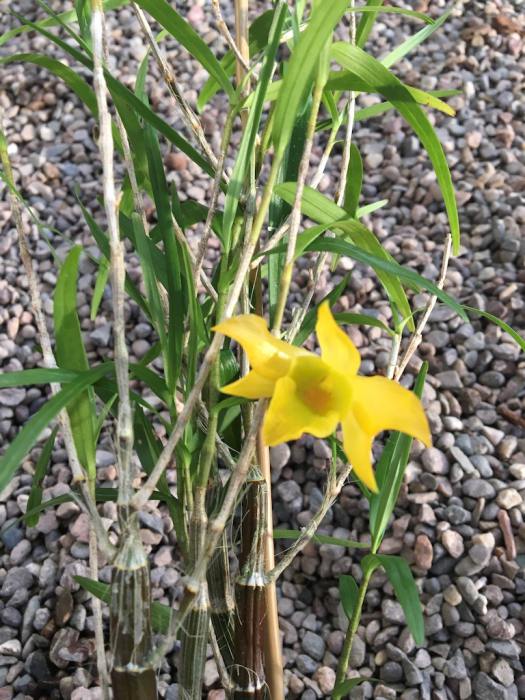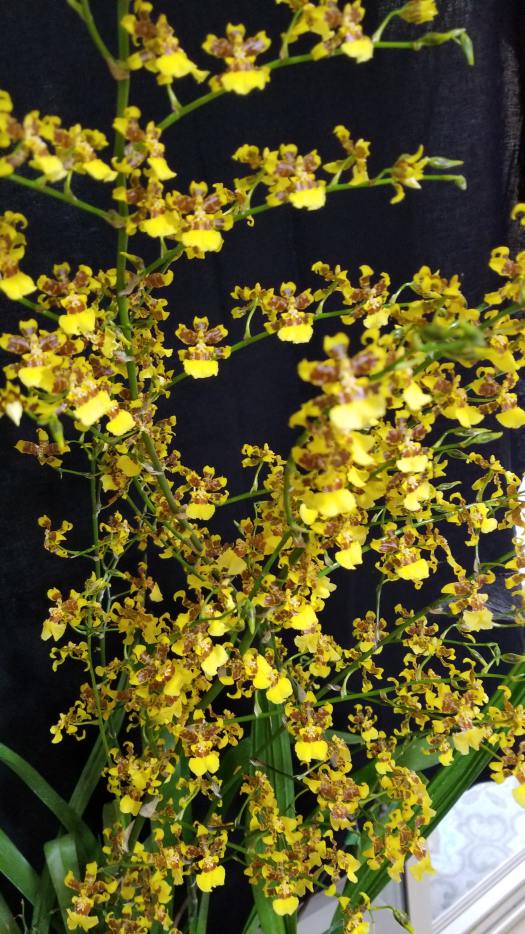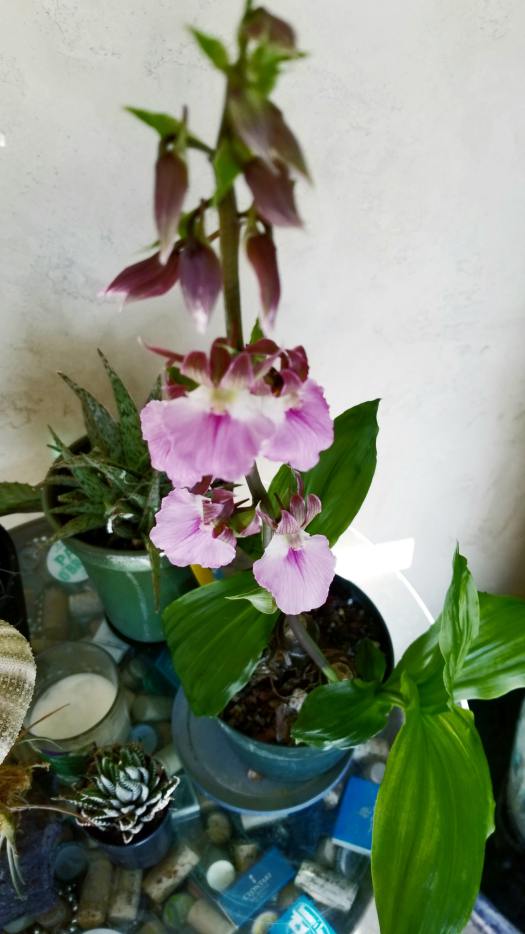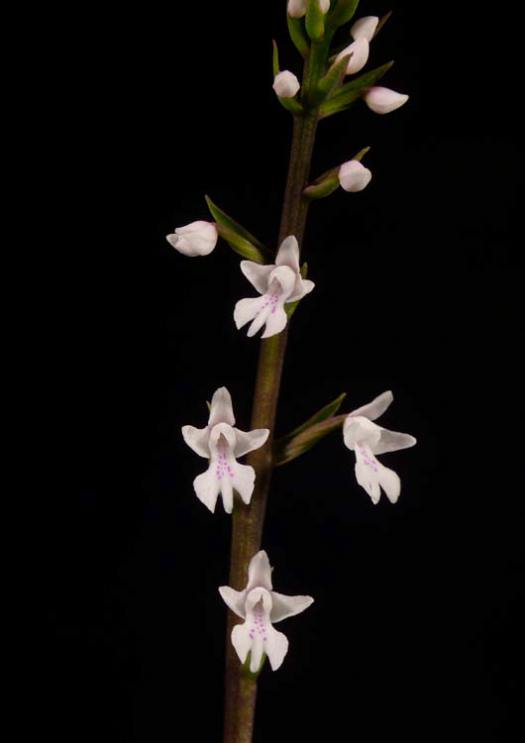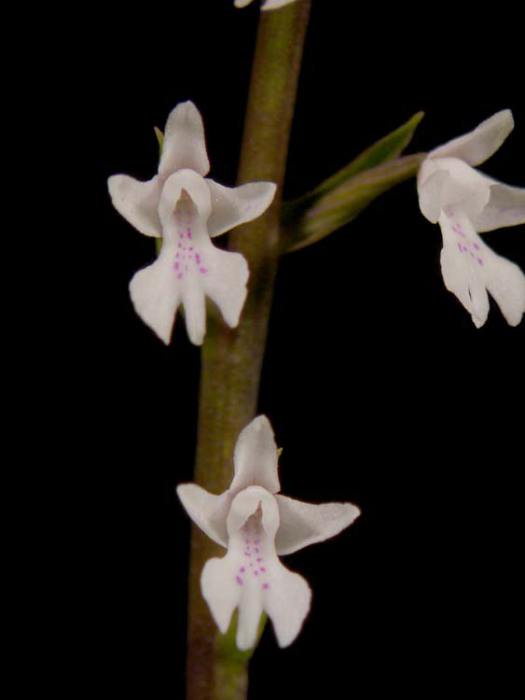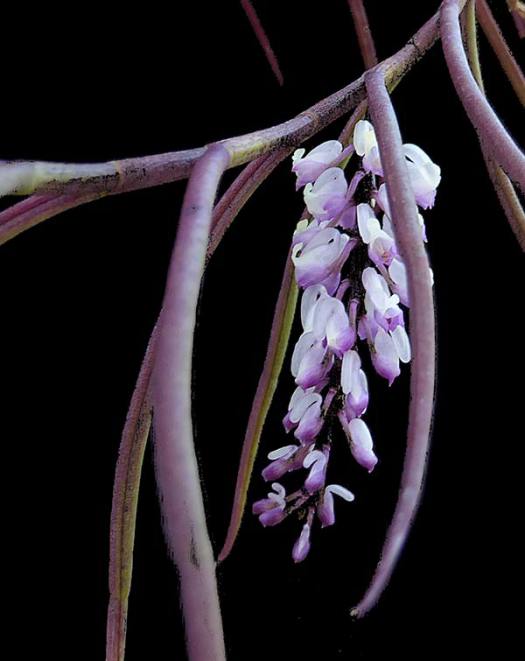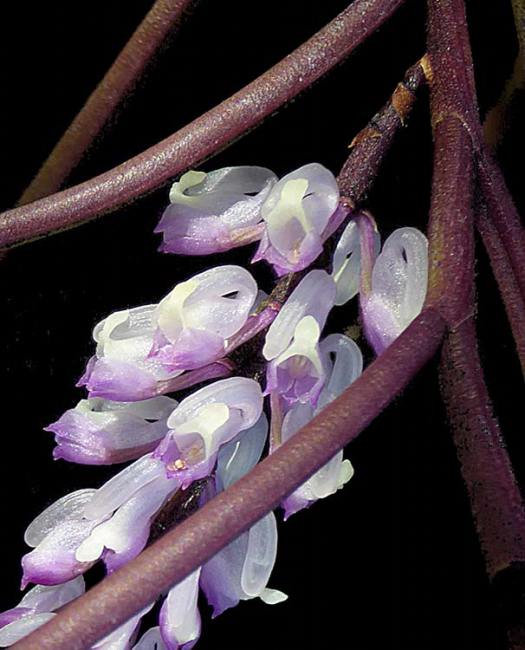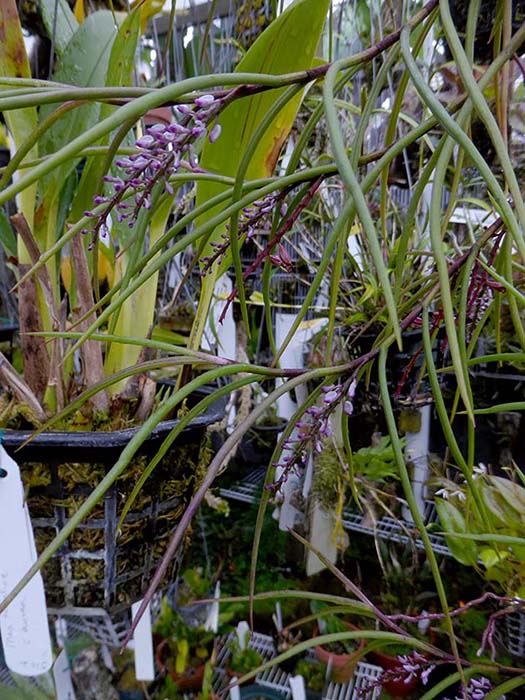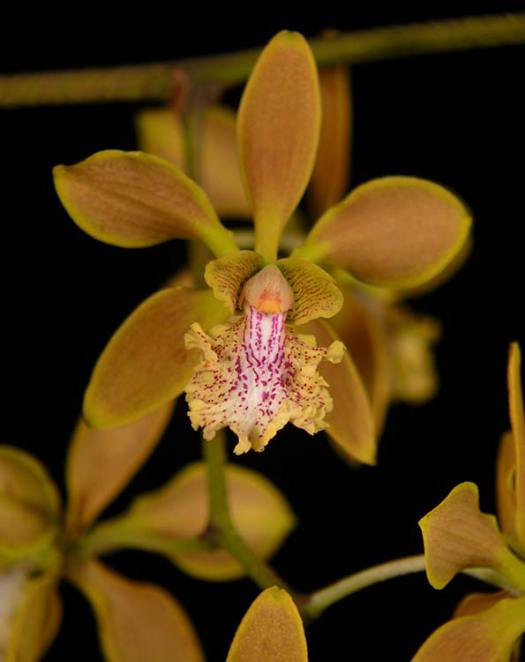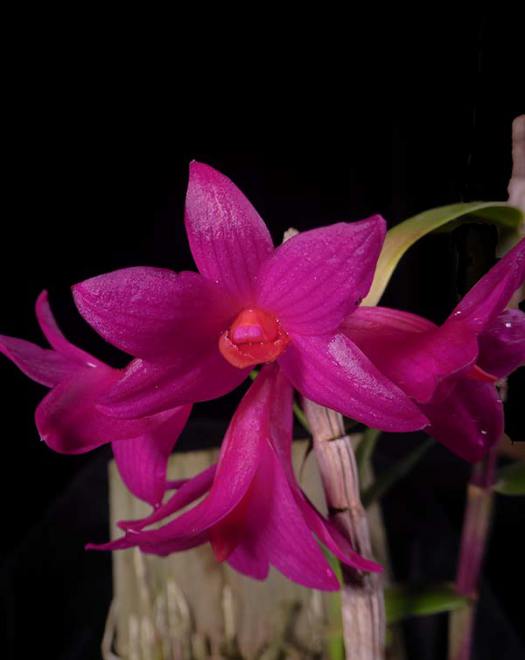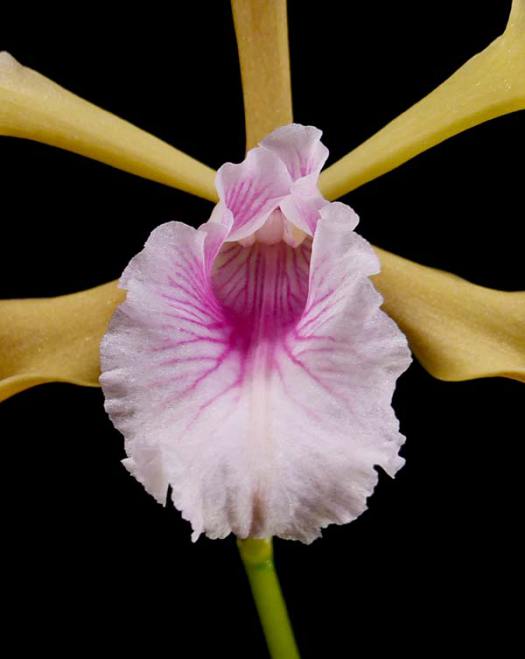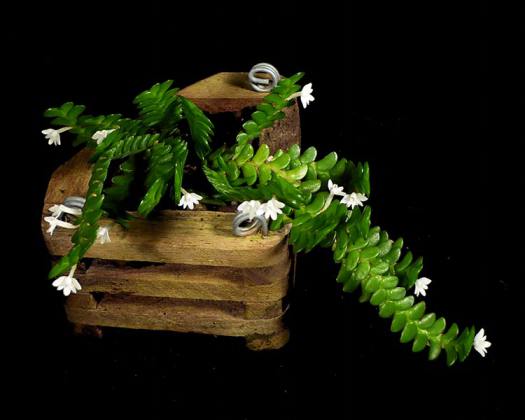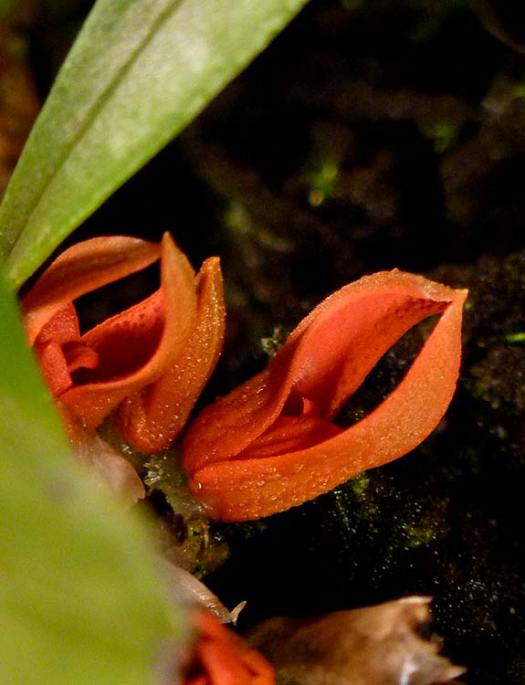August 2019
From Cindy Jepsen:
|
|
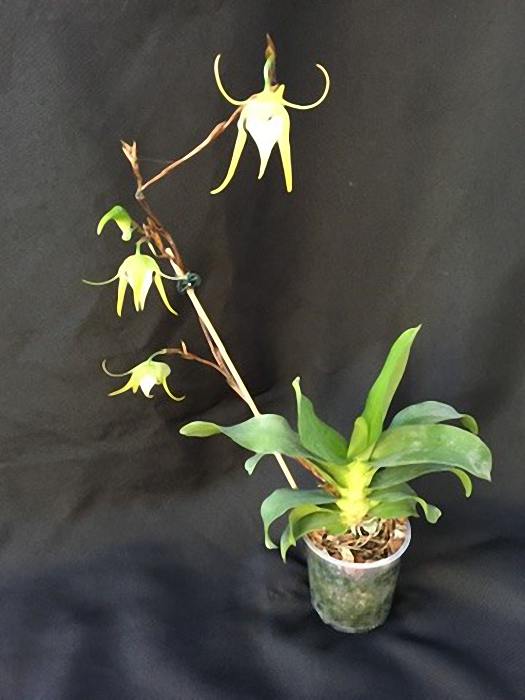 |
|
Aeranthes grandifloraThis species is fairly new to me and it’s been in spike for about 4 months. It just recently started opening up. The blooms are a beautiful greenish yellow and are wax-like. It’s grown in bark and sits on a north facing window in my glass greenhouse receiving intermediate morning light. Humidity is at 65% and I’ve been able to keep my high temps around 83°, it’s getting to 108° outside. I water with an RO system several times a week and feed weekly with MSU, seaweed and Superthrive on a rotating basis. |
|
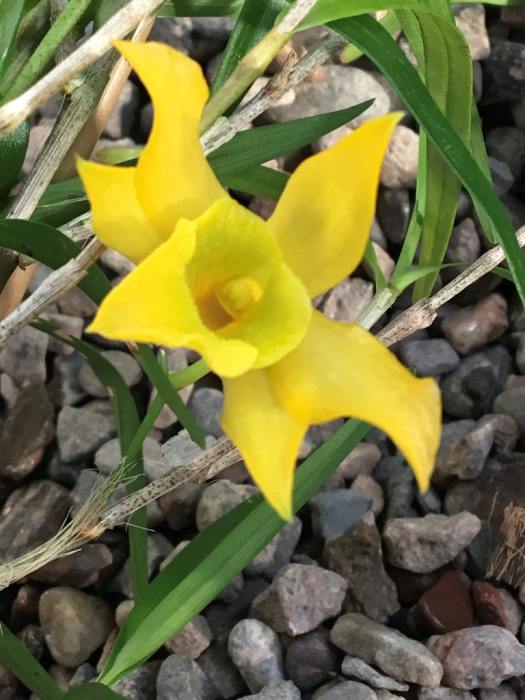 |
|
Dendrobium hancockiiJust got this species and it came with a bud so I can’t take much credit for it. It’s an epiphytic orchid and does have a slight scent. The canes and foliage remind me of bamboo. Right now it is sitting in a basket high in my greenhouse and looks to be potted in bark and moss. I love the bright yellow color. Humidity is at 65% and I’ve been able to keep my high temps around 83°, it’s getting to 108° outside. I water with an RO system several times a week and feed weekly with MSU, seaweed and Superthrive on a rotating basis. |
|
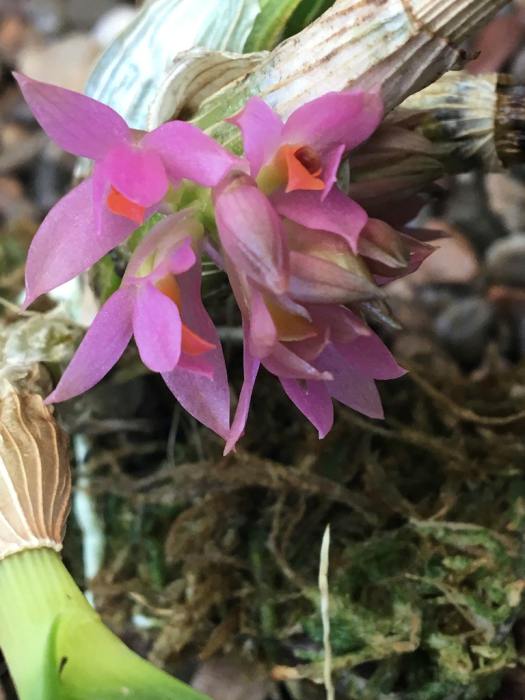 |
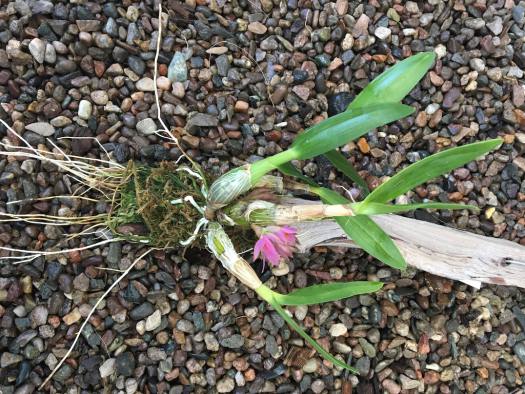
Dendrobium bracteosumI’ve had this species for about 9 months and this is my first bloom(s). I noticed it accidently one day when I was working on an adjacent orchid. It blooms from a cluster of buds and when they are all fully open they look like a beautiful bouquet. It’s mounted on a tree limb with moss and currently resides on an east-facing wall in my glass greenhouse receiving morning sun. I water it every-other day. Humidity is at 65% and I’ve been able to keep my high temps around 83°, it’s getting to 108° outside. I water with an RO system several times a week and feed weekly with MSU, seaweed and Superthrive on a rotating basis. |
From Jan Hennessey:
|
|
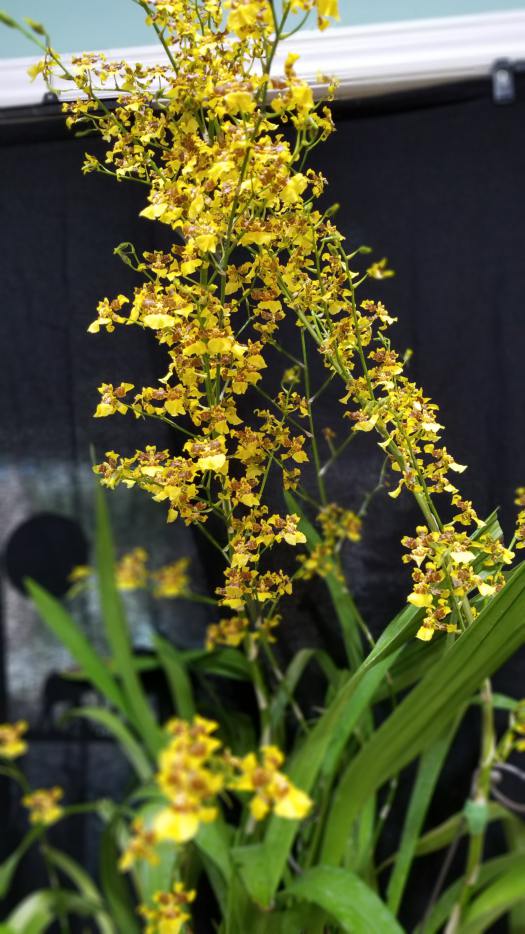 |
|
Oncidium sphacelatumThis had been growing in many locations around the yard for many years. It was just another potted plant. Never a bloom. Last fall I stuck it in my unheated greenhouse and by early spring spikes began to form. One and two by March. But than they just kept coming till I had seven. Also a clump was hanging outside the clay pot and didn't look very nice. So I twisted it off and gave it a new home. It put out 2 spikes as well all on it's own. They did get some time release fertilizer and plenty of water. Go figure. |
|
 |
|
Eulophia quartiniana (guineensis) I've had this plant a few years now, had never bloomed, I didn't even know what it was. So it got drowned in heavy rains this past winter, several times. This spring it got in line to be divided and repotted. I used some of the very sandy mix it was in, and added about equal parts fine bark. Surprise, leaves, than spikes started to form and there you have it. |
|
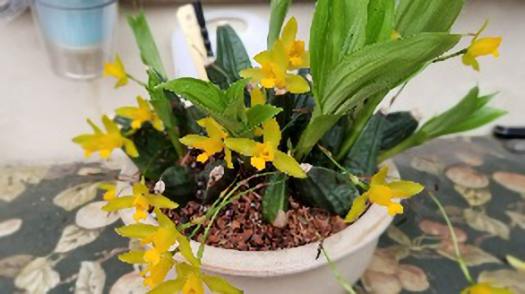
Lycaste aromaticaSo reliable year after year. Grows outside under the eaves, east side of the house. I divided and repotted her this spring so the blooms are not as numerous and the color also not as vivid. But the scent is heavenly, cloves, cinnamon and citrus for me. |
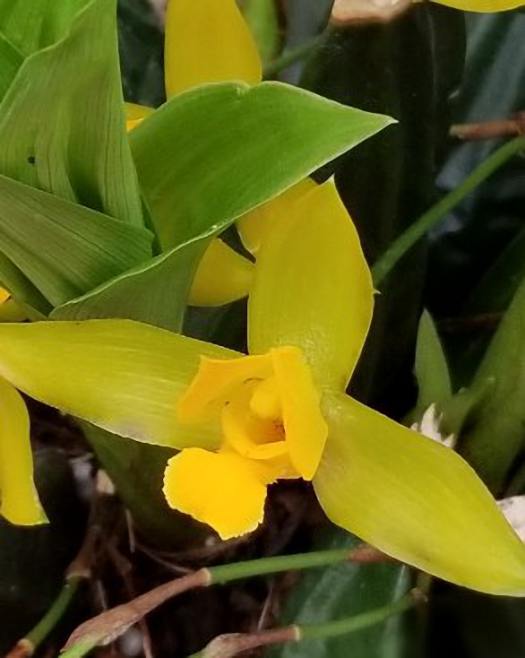 |
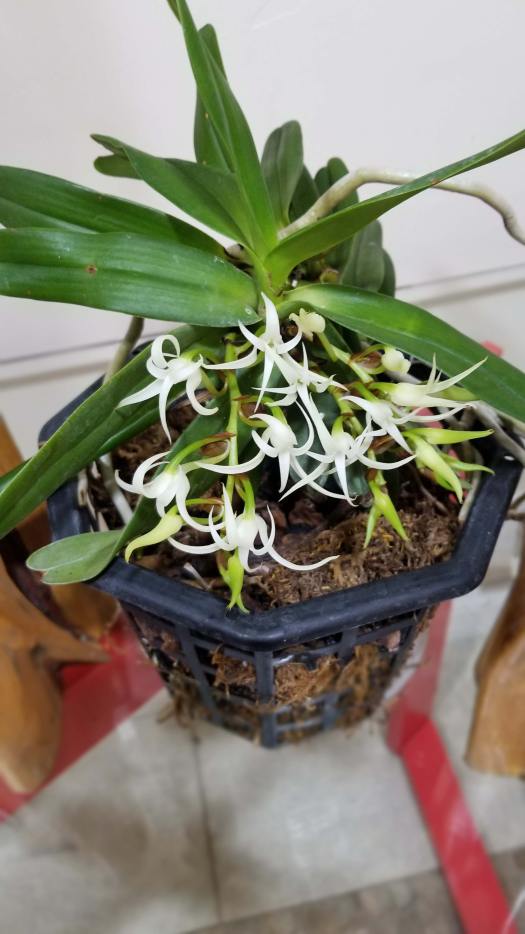 |
 |
Cyrtorchis chailluana (probably)I have had this plant for about a year, came with no name. |
|
From Scott McGregor:
|
|
Angraecum magdelanaeThis is a medium-sized Angraecum that grows well outside and has waxy/fleshy flowers that smell intensely of cloves at night. |
Cleisocentron gokusingiiCleisocentron gokusingii, with very pale blue flowers this time. Anyone figured out how to get the darker blue flowers more often? |
Angraecum sororiumOne of my favorite Angraecums—from Madagascar, frost-tolerant, slow grower up to 2-3’, branches freely at the base and along the main growth. The thick, waxy, 4” white flowers have a 6-12” spur and smell intensely of cloves at night. I grow this one very bright (30-40% shading) for good flower production. It resents root disturbance, so plant it in a relatively large pot with media that will last a decade or more (lava rocks, 20% organics). |
|
Brassia verrucosa
|
|
Bulbophyllum saltatorum var. ciliatumHere’s a fun Bulbophyllum just opening the first of about ten flowers that defies “conventional wisdom”—most sources list this one as a “hot” grower, but it seems to thrive outdoors for me for three years now. I’ve also had good luck with B. barbigerum, which inspired me to give this one a try. Both of these species have fluffy, mimosa-like lips that waft in the slightest breeze, and you do want that breeze because they don’t have a very nice fragrance! |
|
Cattleya (Laelia) purpurata v. carneaJust opening—always a pretty sight. |
Cattleya (Laelia) purpurata v. schusteriana(Scott)"Not as pretty as Roberta’s “profusion of purpurata”, but these are very rewarding." (Ed.: It's pretty!) |
Dichaea glaucaThis is an unusual orchid with flowers that hang down beneath 2nd and 3rd year braided growths. And no, those aren’t bugs on the flowers—it has natural freckles. It has a sweet fragrance as well. |
|
Domingoa (Nageliella) angustifolia (purpurea)I have two identical-looking plants with rather different flowers that seem to be some variations of Domingoa angustifolia, with synonym genus Nageliella and synonym species purpurea. One the web, these seem to be comingled as well. Open to any suggestions of appropriate naming of these tiny plants. They rebloom on old flower stalks in following years, so never cut these, even if you’re sure they look dead. |
|
Diplocaulbium arachnoideum, again Really liking this Diplocaulbium arachnoideum. Have owned it for almost a year and it has flush bloomed like this or better in both October and November of 2018, and so far this year in each of February, March, May, June, and now July. All the flowers open at once, last only a day, but smell intensely of fresh-cut watermelon. I have a smaller D. aratriferum and coincidently or otherwise, it flush blooms on the identical day as this one each time. The plants aren't grown near each other-- wonder how they do that! |
Dracula roezliiDraculas love our Southern California May gray and June gloom days, and for those near the coast and who have r/o water, are relatively easy growers. D. roezlii, like most Draculas, flowers downward, and should always be potted loosely with sphagnum moss in a basket. The simian-looking flowers have long tails, and usually droop on warm afternoons. |
Encyclia adenocaula ssp. guadalupeaeA temperature tolerant Encyclia from Mexico. |
Encyclia vitellinaMy favorite Encyclia-- fully saturated color! Even better now that it's fully opened. |
Eria panneaSmall fuzzy flowers. |
Bug patrol!Newest member of my bug (and maybe also slug) patrol! Current fav name choice is “,” (A veiled chameleon. They are supposedly hardy enough to handle our winters. We’ll find out. He sure likes to eat crickets— ate about half a dozen in a few minutes...) |
Jumellea ibityanaStill in bloom from last month, but now with more flowers open. |
Restrepia brachypus v. striataA cute summer-blooming striped Restrepia, originally a gift from Edie. Restrepias are mostly cloud-forest dwellers and like cool and moist conditions.
|
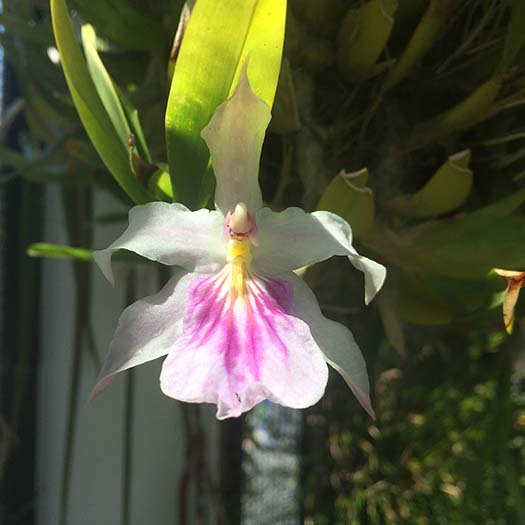 |
|
Miltonia spectabilisMiltonia spectabilis is one of the earlier Miltonia species to flower. It rambles, so best grown in baskets and allowed to form a large ball. |
|
Mystacidium capenseThis fragrant angraecoid from South Africa is a tiny, shade-loving plant that outdoes itself with flowers every July. |
|
Pleurothallis sarracenia (Acianthera bragae)Here’s an odd one. A creeping (creepy) mini, named after the genus Sarracenia, or carnivorous “pitcher plants”, because of the unusual flower shape that resembles the pitchers. I think the flowers look more like slugs, and ironically I didn’t notice the plant was in bloom until looking for slugs at night! |
|
Schoenorchis gemmataSchoenorchis gemmata is a vandaceous plant that grows widely across mountainous regions in Asia. The 5mm flowers are tiny but plentiful, and open sequentially on the spikes so the plant is in bloom for 4-6 weeks. |
|
Schoenorchis scolopendriaThis is a creeping mini-mini that eventually covers its mount. I grow it on the bright side, which turns the leaves reddish-purple and makes for an interesting plant in or out of bloom. It is nicknamed the millipede orchid as it resembles a millipede growing in the folds of tree bark. |
|
Sobralia callosaWhat a pretty sight to see on a bright sunny morning—a flush bloom of Sobralia callosa! Most list this as a warm grower, but seems to do fine outside for me. It is an epiphyte though, so pot in a loose epiphytic mix. Sadly, the flowers only last one day, but bloom repeatedly from the same growth. |
|
Sobralia macrantha |
Sobralia rogersiana 'de Brito'There has been a lot of debate about varietals of Sobralia macrantha over the years, as they come in tall and short forms, and with varying sizes and shapes of flowers. Originally described as S. macrantha ‘Bolin’, this is now recognized as S. rogersiana. It looks the same as macrantha except the lip is significantly bigger and more crepe-like, and generally has better flower form. Here’s a named varietal of rogersiana—a spectacular flower. Too bad it only lasts a few days, but the bloom sequentially. [Compare with S. macrantha, also in bloom this month]
|
Sobralia undatocarinataSummer is Sobralia time, and S. undatocarinata (along with the similar looking S. maduroi) is one of my favorite small Sobralia species. There are supposedly three different varieties of this species, which is endemic to Panama and Costa Rica. Variety “chica” is the dwarf form from Panama, so I assume that’s what my full grown 16” plant probably is. It has multiple blooms in succession on each mature growth, that are both fragrant and long-lasting (up to a week), which is unusual for Sobralias. Hard to find, but well worth the search.
|
|
Dendrobium devonianumA pretty summer-blooming Himalayan Dendrobium—color, fragrance and fringe! Often listed as a warm (min 58F) grower, but does fine for me outside since 2015, including getting rained on in the winter. |
Stenoglottis macloughliniiA small winter-deciduous terrestrial—I find these are happiest if grown very bright and moist in sandy soil. These were originally sold as S. woodii/woodsii, but later corrected to S. macloughlinii. |
Cattleya (Laelia) tenebrosa f. aurea |
Cattleya (Laelia) tenebrosa
|
From Roberta Fox:
|
|
Outside in the back yard |
|
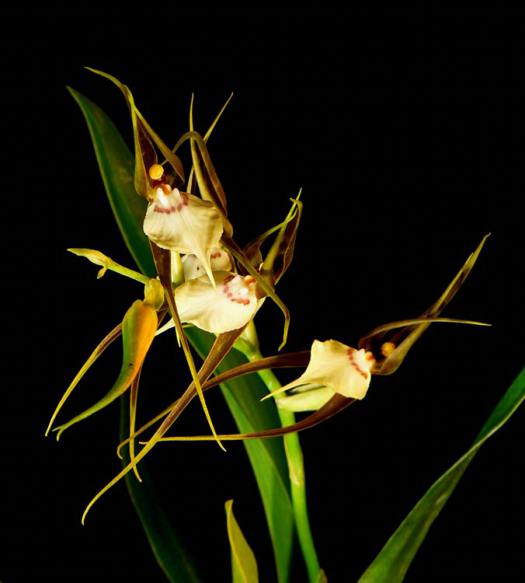
Ada (Brassia) glumaceaFlowers are not dramatic, so I often smell this before I see it in bloom hanging high in my growing area. It is intensely fragrant, smelling to me something like ripe peaches. |
|
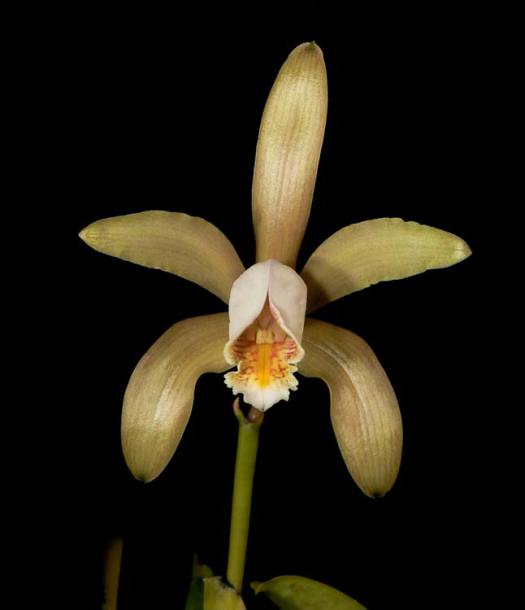
Cattleya forbesiiColor isn't spectacular, but it's nearly bulletproof. It blooms several times a year (and in each season gives two or more sets of blooms), and is very cold-tolerant. |
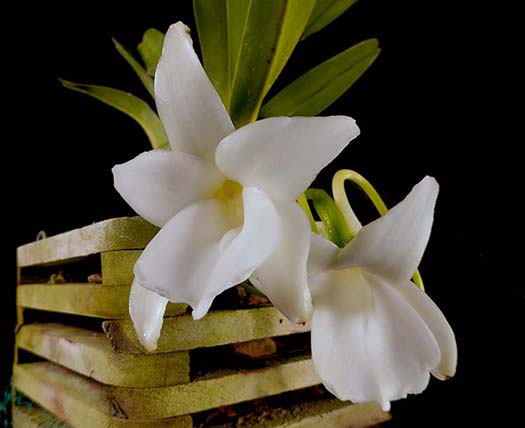
Angraecum magdelanaeTwo flowers this year, sweetly fragrant at night. This is a durable plant that has survived rookie mistakes. |
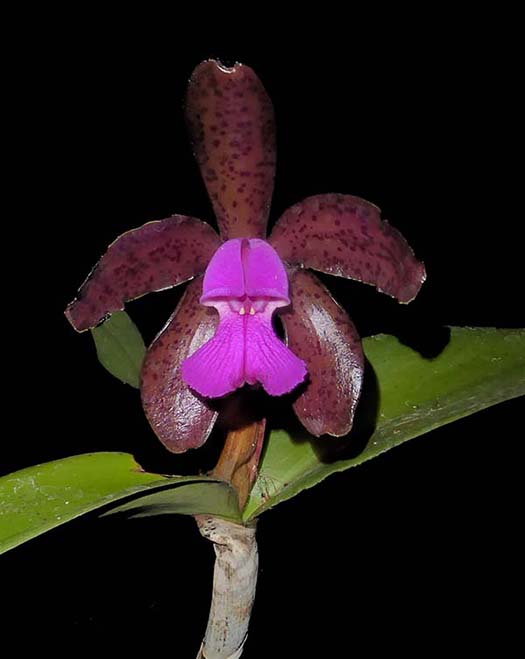
Cattleya leopoldii (tigrina)This year I watched a lovely head of buds develop, then went out one morning to find most of them gone. I examined the sheath, and found a very fat caterpillar, which I gleefully dispatched. One bud did survive. The plant put all of its energy into that one flower, and it was larger and darker than in previous years. |

Cattleya leopoldii (tigrina)I got this one as a seedling, supposedly a coerulea x self. Clearly it's not coerulea (either mis-labled, or genetic variation) , but perhaps even more interesting... It is peloric - the lip color is echoed in the petals, though in the edges rather than the mid-rib. |
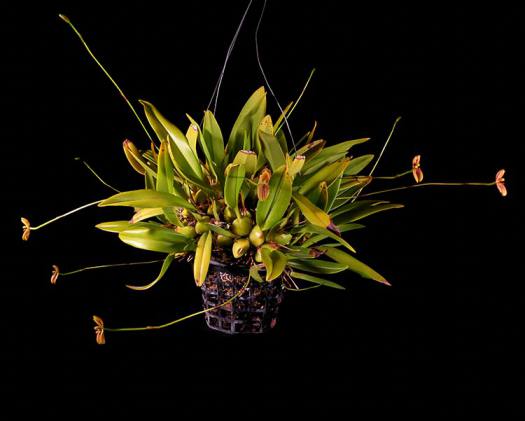 Mormolyca ringensThis plant is almost always in bloom. Flowers are about 3/4 inch. New pseudobulbs may grow above existing ones as well as to the side, so it almost forms a ball. It does not seem to care about the medium in the basket, so I just let it go and don't disturbe it. |
 |
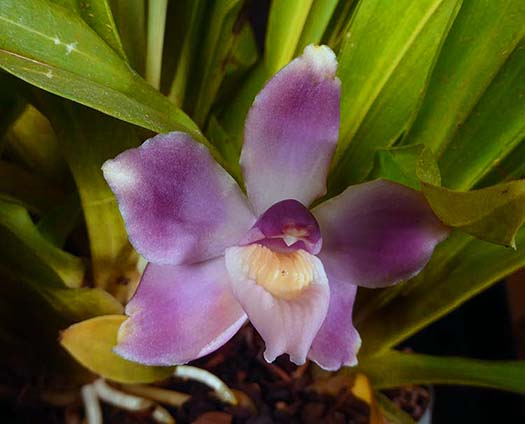
Bollea ecuadoranaLabeled as Bollea coelestis, but color is not coerulea, and the lip is different. Identified by Ron Parsons. Flowers have heavy, waxy substance. |
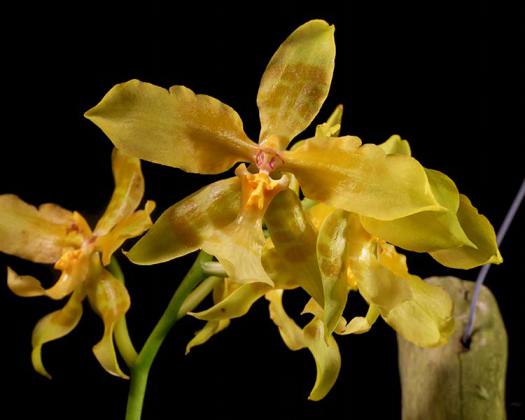
Rossioglossum schlieperianum f. aureaFlowers heavy subsance, almost glossy. The typical form has darker brown banding.
|

Encyclia ambiguaA reliable bloomer, growing in bright shade or filtered sun. |
|
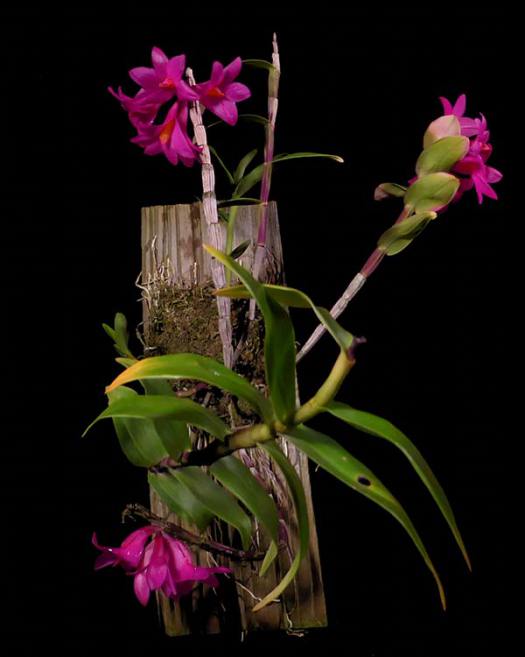 |
|
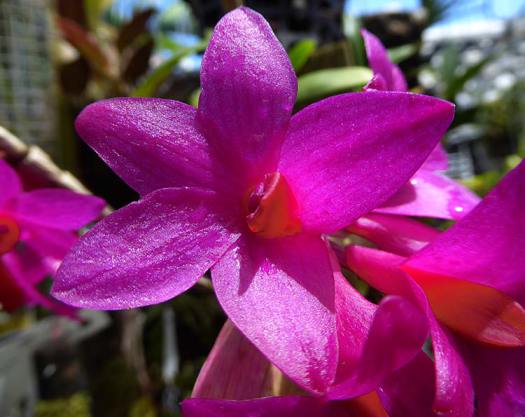 |
Dendrobium glomeratumPhotographs only give a hint of the brilliance of these flowers. The lip is bright orange, whch makes the magenta flowers seem even more vibrant. This species has a reputation for being a warm grower, but it does fine outside. It is very possible that there are populations from different elevations with different degrees of cold-tolerance. |
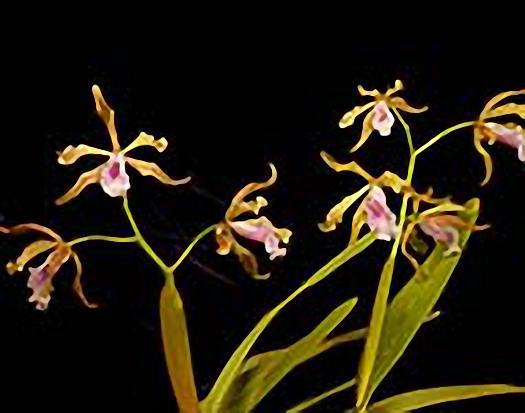 Laelia grandisGrows in filtered sun, conditions similar to Laelia purpurata. |
|
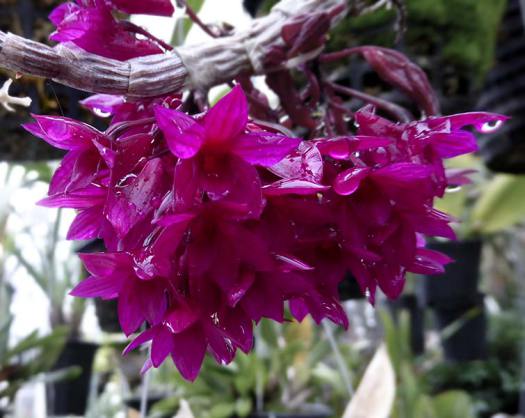 Dendrobium miyakeiBotanically considered a synonym of Den. goldsmidtianam, but that one is a warm grower. This is smaller, but also very cold-tolerant. It is probably from a high-elevation population. It flowers repeatedly on old canes - don't cut them until they are totally brown and shriveled. |
|
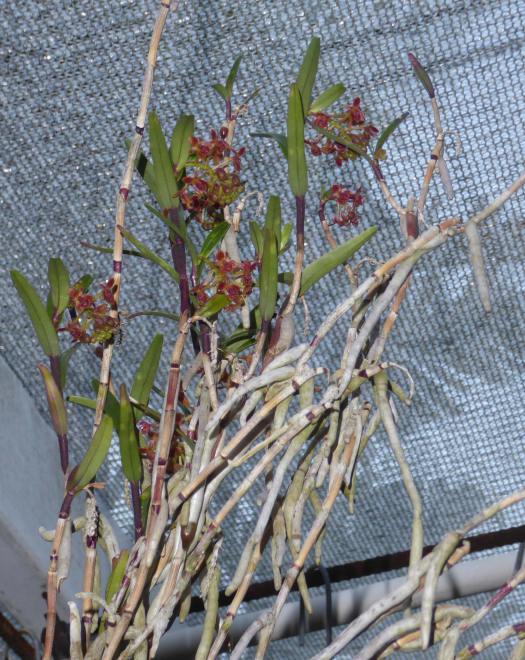 |
 Epidendrum globiflorumProduces keikis freely. It is a climber, that tends to grow off its mount and not care. |
 |
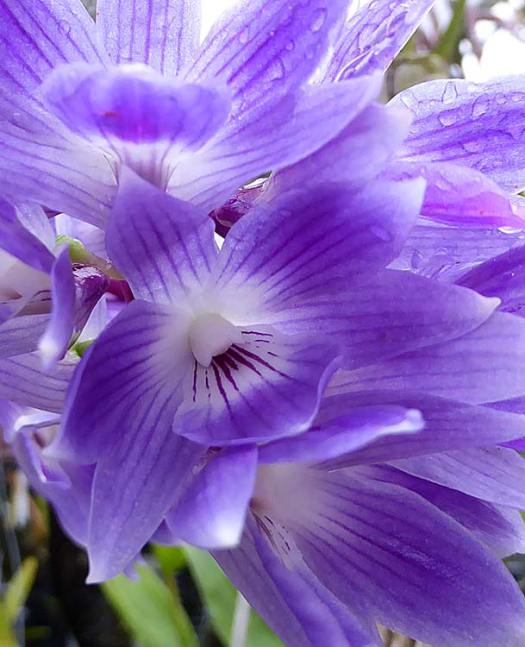 |
Dendrobium victoria-reginaeBlooming on old canes, this Dendrobium grows outside easily. It does seem to to better with RO water. |
|
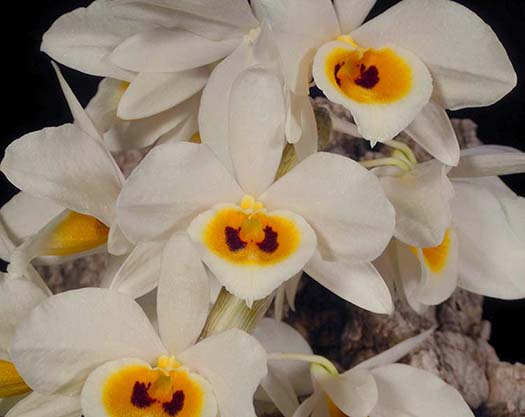
Dendrobium bensonaeThis goes completely deciduous in the winter. I put it where it won't get rained on, and ignore it until new growth appears, or if it hasn't started growing by around April I start watering lightly and that gets it going. Flowers have a sweet banana fragrance. |
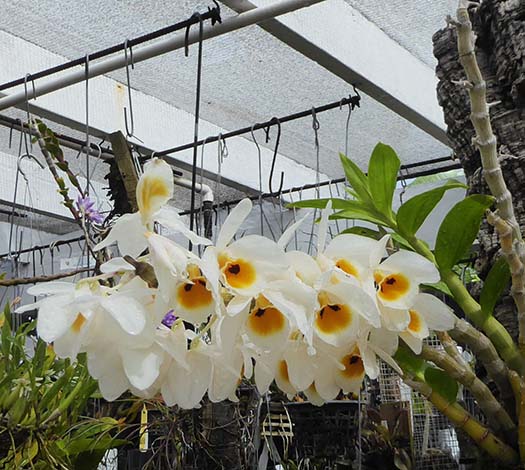 |
 |
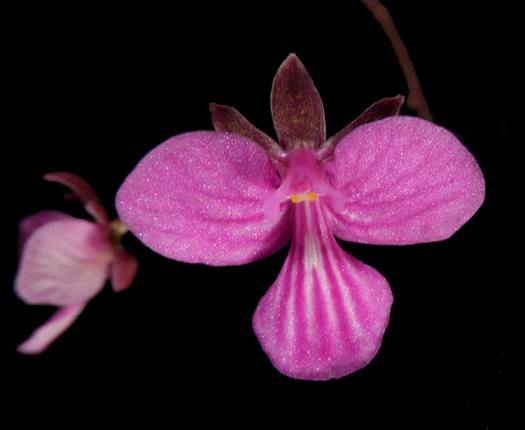
Tetramicra canaliculataSmall (3 inch) plant wih succulent leaves produces flowers on a long, wiry spike. It is a member of the Cattleya tribe. |
Dracula bellerophonFlowers seems to be somewhat warmth-tolerant, staying open through most of the day. |
|
 |

Sobralia sanderaeLots of flowers on a compact plant. Flowers don't last long, but bloom sequentially. Colors stay stronger when the weather is cool. |
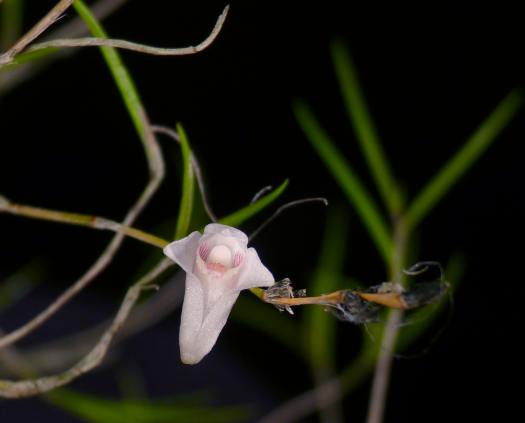
Dendrobium tenellumI first tried growing this in the greenhouse, where it nearly died. It has done much better outside, this year producing lots of new growths with branching, needle-like leaves. I expect more flowers in the future, since it blooms on older growths. |
 |
 |
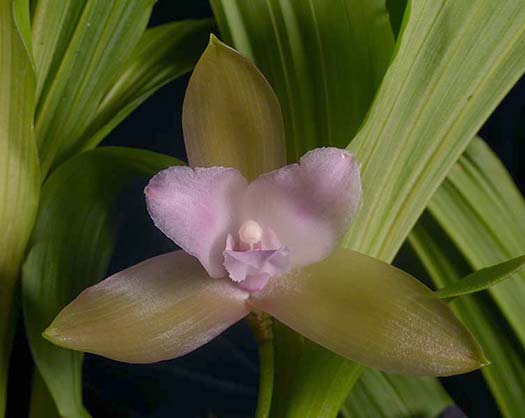 |
Lycaste tricolorThis is the best blooming that I have had from this plant, around 20 flowers open at the same time. I'm not sure where the name comes from, I only see two colors, unless a bit of white in the throat counts. |
|
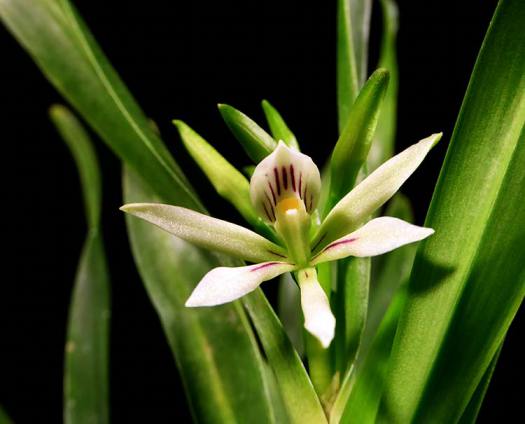
Encyclia (Prosthechea) abbreviataLots of one inch flowers |
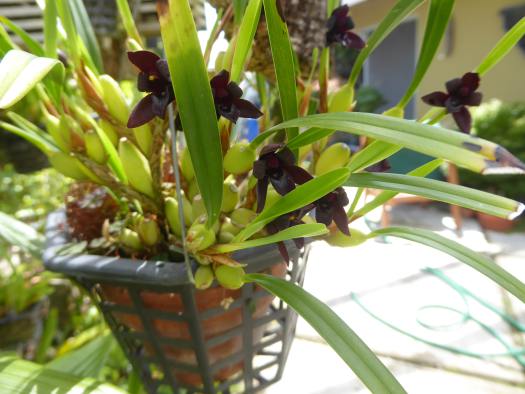
Maxillaria variabilis 'Black-eyed Susan'A flush bloom of an almost-black form of Max variabilis (actually, very dark burgundy) |

Polystachya zambesiacaA cool-growing member of a genus where most species need warmth. |
 |
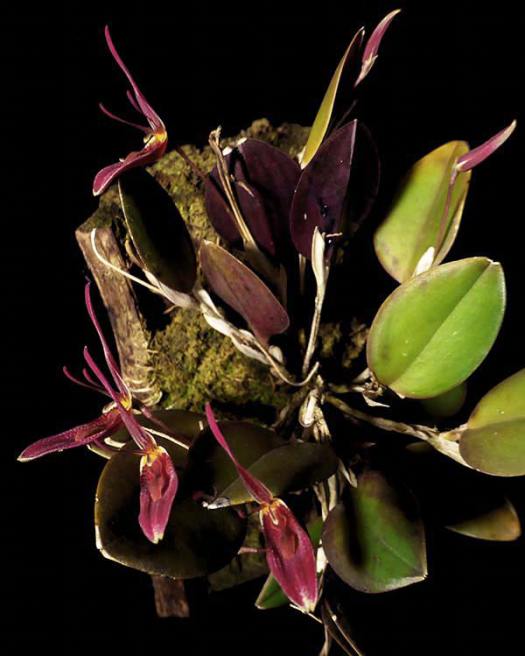 |
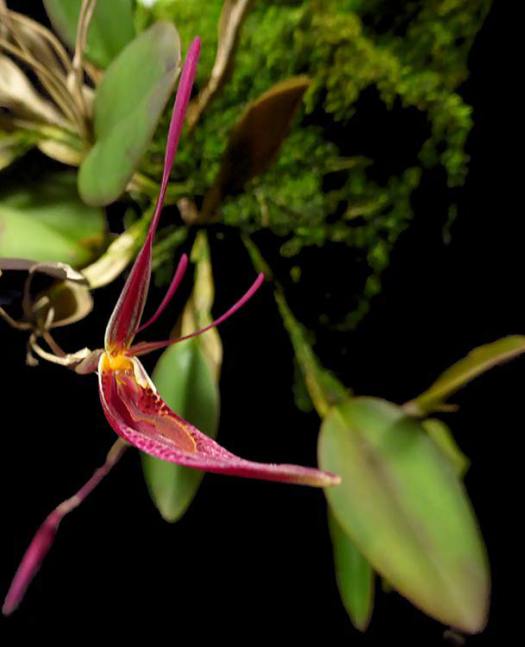
Resetrepia condorensisAlmost always is in bloom, but this month has produced a nice flush of flowers at the same time. |
 |
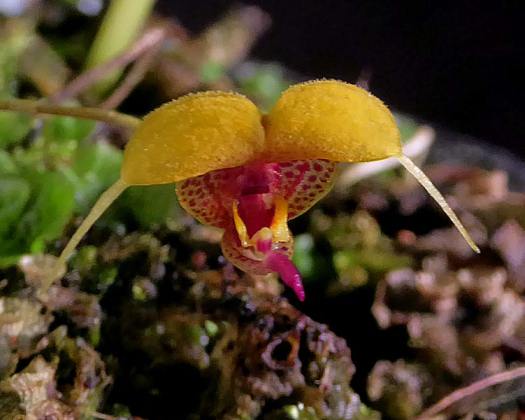 |
Scaphosepalum merinoiBlooms successively on the spike. |
Scaphosepalum swertifolium ssp. exiguumBlooms successively on a spike, and plant is starting to produce more spikes simultaneously. |
In the greenhouse... |
|

Macroclinium dalstroemiiTiny, ephemeral flowers remind me of a dandelion. It can produce several umbels of flowers in succession from each spike. |
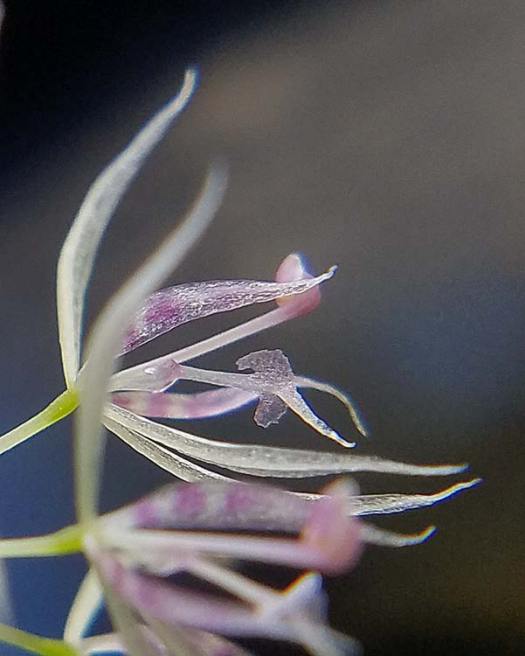 |
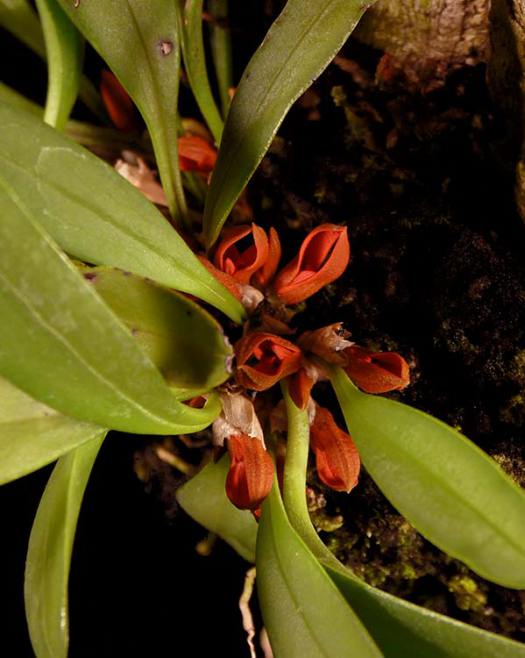 |
|
Pleurothallis tribuloidesFlowers hide at the base of the plant, but become obvious once they are open |
|

